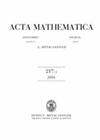第二个非平凡Neumann特征值的最大化
IF 6.7
1区 数学
Q1 MATHEMATICS
引用次数: 30
摘要
本文证明了在给定测度为m的rn光滑域上拉普拉斯算子的第二(非平凡)Neumann特征值在两个测度为m2的不相交球的并集上达到最大值。因此,诺伊曼特征值的P{\'o}lya猜想对第二个特征值和任意域都成立。此外,我们还证明了在非光滑域和非光滑密度的情况下,相同不等式的松弛形式成立。本文章由计算机程序翻译,如有差异,请以英文原文为准。
Maximization of the second non-trivial Neumann eigenvalue
In this paper we prove that the second (non-trivial) Neumann eigenvalue of the Laplace operator on smooth domains of R N with prescribed measure m attains its maximum on the union of two disjoint balls of measure m 2. As a consequence, the P{\'o}lya conjecture for the Neumann eigenvalues holds for the second eigenvalue and for arbitrary domains. We moreover prove that a relaxed form of the same inequality holds in the context of non-smooth domains and densities.
求助全文
通过发布文献求助,成功后即可免费获取论文全文。
去求助
来源期刊

Acta Mathematica
数学-数学
CiteScore
6.00
自引率
2.70%
发文量
6
审稿时长
>12 weeks
期刊介绍:
Publishes original research papers of the highest quality in all fields of mathematics.
 求助内容:
求助内容: 应助结果提醒方式:
应助结果提醒方式:


